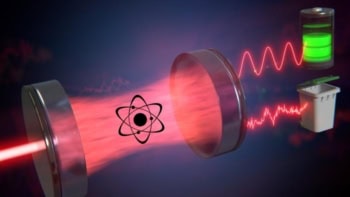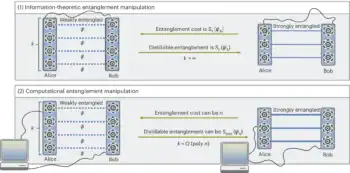
Physicists in the US have calculated that a new class of three-body bound states should exist for atoms that experience long-range interactions – even though the interactions themselves are too weak to bind pairs of the same atoms. Such states have previously been seen in bosonic atoms affected by short-range interactions, but the team says that this latest phenomenon is very different, particularly because it can also occur for fermions. Although the researchers have not yet seen the new states, these could be revealed in experiments on ultracold atomic gases.
The idea that three atoms can form a loosely bound quantum state – even if any two of the atoms on their own cannot bind together – was first predicted by the Russian physicist Vitaly Efimov in the early 1970s. Now known as Efimov three-body bound states, they were first spotted in 2006 in a gas of caesium atoms that was cooled to just 10 nK by a team led by Hanns-Christoph Nägerl of Innsbruck University in Austria. Efimov states only occur for atoms that are bosons; that is, atoms that have integer, rather than half-integer, values of spin.
The long and the short of it
One important feature of Efimov states is that the interactions between the atoms are short ranged – in other words, they are described by an attractive potential that falls off faster than the inverse square of the distance between atoms. If the potential has a longer range, then Efimov’s calculations do not apply and Efimov states do not exist. Of course, if these long-range potentials happen to be strong, then there will be an infinite number of three-body bound states – but these are not Efimov states.
Until now, however, it has not been clear if three-body bound states exist when the potential is so weak that it does not bind together pairs of atoms. What Brett Esry and colleagues at Kansas State University have found is that bound states of three atoms should occur when they are attracted to each other by a very weak inverse-square potential. The team came to this conclusion by studying numerical solutions to the three-body Schrödinger equation for three identical bosons.
Esry does it
Esry and colleagues then turned their attention to fermions and obtained a second surprising result. When the spins of all three atoms point in the same direction, three-body bound states occur even when atoms in pairs repel each other.
Esry told physicsworld.com that it may be possible to see the new states in lab experiments. “Given that they are very weakly bound – much like Efimov states – ultracold gases are the most likely candidates for seeing them,” he says. “The most likely scenario for seeing our states is in a mixture of heavy bosonic atoms interacting with light fermionic atoms.”
In this scenario, the fermions act as force mediators resulting in an effective attractive inverse-square potential between the bosons. While Esry believes that the effect could reveal itself in a gas of bosonic caesium and fermionic lithium, more ideal candidate systems should have a larger mass ratio between the boson and fermion. Possible systems include ytterbium–hydrogen or erbium–hydrogen, although Esry points out that hydrogen is particularly difficult to work with so lithium might be a better choice of fermion.
Nägerl says he “would not have expected” this result, adding that it is “surprising how rich the [inverse square] case is”. However, Nägerl believes that it may be difficult to persuade experimentalists to try to confirm the theoretical result because of the challenges associated with tooling up their labs to create and study an appropriate boson–fermion combination.
The work is described in Physical Review Letters.



